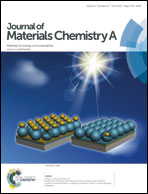Enhanced photocatalytic mechanism for the hybrid g-C3N4/MoS2 nanocomposite†
Abstract
Here, we explore the enhanced photocatalytic mechanism for the hybrid g-C3N4/MoS2 nanocomposites for the first time by performing extensive density functional theory calculations. The calculated band alignment between the g-C3N4 monolayer and MoS2 sheets clearly reveals that the conduction band minimum and valence band maximum of the g-C3N4 monolayer are higher by about 0.83 eV and 0.15 eV respectively than those of the MoS2 sheet. This predicted type-II band alignment ensures the photogenerated electrons easily migrate from the g-C3N4 monolayer to the MoS2 sheet, and leads to the high hydrogen-evolution reaction activity. The charge transfer between MoS2 and g-C3N4 results in a polarized field within the interface region, which will benefit the separation of photogenerated carriers. The calculated optical absorption curves verify that this proposed layered nanocomposite is a good light-harvesting semiconductor. Moreover, a g-C3N4 bilayer covering a MoS2 sheet also displays desirable properties. These findings indicate that the MoS2 sheet is a promising candidate as a non-noble metal co-catalyst for g-C3N4 photocatalysts, and also provide useful information for understanding the observed enhanced photocatalytic mechanism in experiments.


 Please wait while we load your content...
Please wait while we load your content...